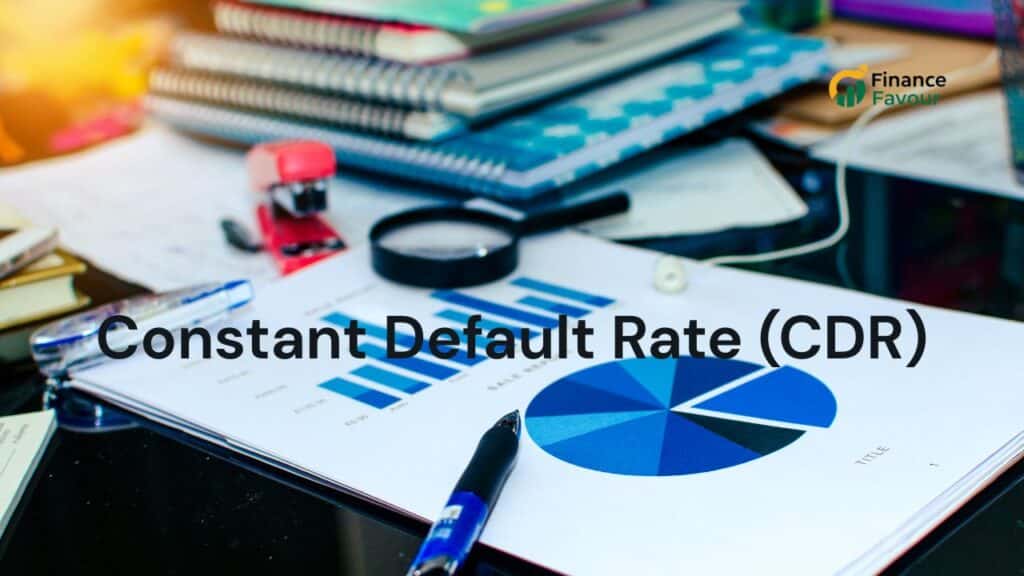Understanding the intricacies of the Constant Default Rate (CDR) is crucial for investors and financial analysts navigating the complex world of credit risk and financial derivatives. As a key metric in assessing the likelihood of defaults within a loan portfolio, the CDR provides valuable insights into the stability and performance of investment vehicles, such as credit default swaps. By delving into the CDR definition and exploring how CDRs work, investors can refine their investment strategies and mitigate potential risks. In this post, we aim to demystify the potential risks of CDRs while highlighting their pivotal role in shaping informed, confident financial decisions.
Understanding Constant Default Rate
The Constant Default Rate (CDR) is a fundamental concept in credit risk management and financial derivatives. Let’s explore its definition, importance, and role in the financial world.
CDR Definition Explained
The Constant Default Rate (CDR) is a metric used to estimate the percentage of a loan pool that is expected to default over a specific period. It’s typically expressed as an annualized rate.
CDR provides a snapshot of the health of a loan portfolio, helping investors and analysts gauge potential risks. It’s particularly useful in assessing mortgage-backed securities and other asset-backed investments.
Understanding CDR is crucial for making informed investment decisions, especially in complex financial instruments where default risk plays a significant role.
Importance in Credit Risk Management
CDR serves as a cornerstone in credit risk management, offering valuable insights into the potential for defaults within a loan portfolio.
By analyzing CDR trends, financial institutions can:
- Adjust their lending strategies
- Price loans more accurately
- Set appropriate reserves for potential losses
CDR also helps in comparing different loan portfolios, allowing investors to make more informed decisions about where to allocate their capital.
Role in Financial Derivatives
In the world of financial derivatives, CDR plays a crucial role in pricing and risk assessment, particularly for credit default swaps (CDS) and collateralized debt obligations (CDOs).
For CDS, the CDR helps determine the premium that should be charged to protect against default. Higher CDRs typically result in higher premiums, reflecting the increased risk.
In CDOs, understanding the CDR of underlying assets is essential for structuring the tranches and determining appropriate yields for each risk level.
How CDRs Work
Understanding the mechanics of CDRs is crucial for investors and financial professionals. Let’s dive into the calculation process, its impact on credit default swaps, and how it influences investment strategies.
Mechanism of CDR Calculation
The CDR calculation involves a systematic approach to estimating the rate at which loans in a portfolio are expected to default over time.
To calculate CDR:
- Determine the total number of loans in the portfolio
- Identify the number of new defaults in a given period
- Annualize this rate to get the CDR
The formula can be expressed as:
CDR = 1 – (1 – m)^12
Where ‘m’ is the monthly default rate.
This calculation provides a standardized measure that can be used to compare different loan portfolios or track changes over time.
Impact on Credit Default Swaps
CDR significantly influences the pricing and risk assessment of credit default swaps (CDS), which are financial contracts designed to transfer credit risk.
A higher CDR typically leads to:
- Increased CDS premiums
- Greater perceived risk in the underlying assets
- More conservative valuations of CDS contracts
Conversely, a lower CDR might result in more favorable terms for the protection seller and potentially lower costs for the protection buyer.
Understanding these dynamics is crucial for both parties involved in CDS transactions, as it directly affects the economics of the deal.
CDR in Investment Strategies
Incorporating CDR analysis into investment strategies can help investors make more informed decisions and better manage risk in their portfolios.
Key considerations include:
- Using CDR to compare different investment opportunities
- Adjusting portfolio allocations based on CDR trends
- Developing hedging strategies to mitigate default risk
By leveraging CDR insights, investors can potentially enhance returns while maintaining a balanced risk profile across their investments.
Risks of CDR
While CDR is a valuable tool, it’s important to understand its limitations and potential risks. Let’s explore some key pitfalls, mitigation strategies, and long-term implications for investors.
Identifying Potential Pitfalls
CDR, while useful, has several potential pitfalls that investors should be aware of:
- Oversimplification: CDR assumes a constant default rate, which may not reflect real-world variability.
- Historical bias: Relying too heavily on historical CDR data may not account for future economic changes.
- Model risk: The accuracy of CDR calculations depends on the quality of the underlying model and data.
Understanding these limitations is crucial for making informed investment decisions and avoiding overreliance on a single metric.
Mitigating CDR-Related Risks
To mitigate risks associated with CDR, consider the following strategies:
- Use multiple risk assessment tools alongside CDR
- Regularly update and refine CDR models
- Stress-test portfolios under various CDR scenarios
By taking a comprehensive approach to risk assessment, investors can gain a more nuanced understanding of potential default risks and make more robust investment decisions.
Long-Term Implications for Investors
The long-term implications of CDR for investors can be significant:
- Portfolio performance: Accurate CDR analysis can lead to better long-term portfolio performance.
- Risk management: Effective use of CDR can help in maintaining a balanced risk profile over time.
- Market reputation: Consistently outperforming CDR expectations can enhance an investor’s market reputation.
However, it’s crucial to remember that CDR is just one tool in the investor’s toolkit. A holistic approach to risk assessment and investment strategy is key to long-term success.
Strategic Approaches
Integrating CDR into your investment strategy requires a thoughtful approach. Let’s explore how to effectively use CDR in portfolio management, return optimization, and risk assessment.
Integrating CDR in Portfolio Management
Incorporating CDR into portfolio management can enhance decision-making and risk control:
- Use CDR to assess the overall health of your loan portfolio
- Compare CDRs across different asset classes to optimize allocation
- Monitor CDR trends to identify potential shifts in market conditions
By making CDR a key component of your portfolio management process, you can gain valuable insights into the risk profile of your investments and make more informed decisions.
Optimizing Returns with CDR Analysis
CDR analysis can be a powerful tool for optimizing investment returns:
- Identify opportunities where market CDR expectations may be misaligned with your analysis
- Use CDR insights to time entry and exit points in credit markets
- Leverage CDR data to negotiate better terms in credit default swaps or other derivatives
Remember, while CDR is valuable, it should be used in conjunction with other metrics and analysis for a comprehensive investment strategy.
Leveraging CDR for Risk Assessment
CDR can significantly enhance your risk assessment capabilities:
- Use CDR to set appropriate risk thresholds for different investment categories
- Incorporate CDR into stress testing scenarios to gauge portfolio resilience
- Develop early warning systems based on CDR trends to proactively manage risk
By leveraging CDR effectively, you can create a more robust risk management framework that helps protect your investments while pursuing attractive returns.
Real Estate Financing Insights
Understanding CDR’s role in real estate financing can provide valuable insights for investors and lenders alike. Let’s explore how CDR impacts mortgage solutions and real estate investment strategies.
CDR’s Role in Mortgage Solutions
In the realm of mortgage solutions, CDR plays a crucial role in assessing and managing risk:
- Lenders use CDR to price mortgage rates and determine lending criteria
- Investors in mortgage-backed securities rely on CDR to evaluate potential returns and risks
- CDR trends can influence the availability and terms of different mortgage products
Understanding CDR’s impact on mortgages can help both borrowers and lenders make more informed decisions in the real estate market.




